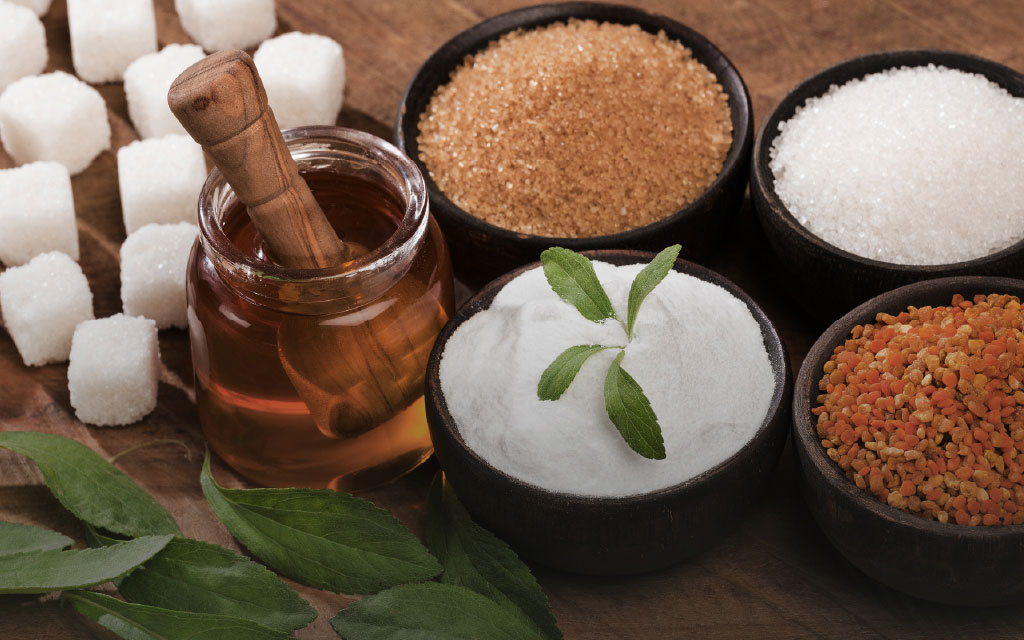
The Skinny on Low-Calorie Simple Syrups
For the entire month of January, we focused on low-calorie, low-carb cocktails. We found that one of the best ways to cut calories is by getting rid of the high amounts of sugar often found in cocktails. Today we’re going to explore sugar free simple syrup as an easy way to cut the carbs in your cocktails.
So we worked with high intensity sweeteners and even talked to an actual food scientist about the science of sugars in order to find alternatives while still keeping our cocktails delicious: the low-calorie simple syrup made with high intensity sweeteners!
Want to jump to a certain topic? Here’s everything we’re going to talk about in this article:

Sugar Free Simple Syrup: A Brief Overview
Simple syrups are a key part of creating balanced cocktails, and are a staple for many cocktails and coffees. The secret to that sweetness is (you guessed it) sugar. As we’ve detailed before, simple syrup is made by dissolving sugar in water; using a simple syrup gives you an easy way to calibrate the sweetness of a drink. (It’s also vital if you want to avoid those annoying granules of sugar that appear when you attempt to dissolve sugar in a cold beverage.)
But by definition, this is not a low-carb addition to your favorite cocktail. Sugar water = calories and carbs. So if you’re on a low carbohydrate, diabetes friendly, and / or low sugar diet, you’re going to need a better solution. Enter: Sugar free simple syrup!
Hang on… “Healthy” Cocktails?
A disclaimer: If you’re going “no carb” for health reasons, it’s also very likely that cocktails aren’t on the menu at all. After all, alcohol isn’t exactly healthy. But if you’re looking for a way to reduce your sugar intake and it’s OK for you to have cocktails – in moderation of course – then read on! Hopefully this article will help

Sugar Substitutes: What to Know
Science brings us some amazing sugar alternatives, but how do they work in cocktails? We tried a lot of options this month and found a couple issues to consider when working with no-calorie and other “no sugar” sweeteners.
Types of Sugar Substitutes
There are two main categories of low calorie alternative sugars: Sugar alcohols and High Intensity sweeteners. A third category, called “Novel Sweeteners“, is a bit of a red-headed stepchild of the other two. They aren’t sugar alcohols but they are naturally derived.
Sugar alcohols are found naturally in some fruits and vegetables and are not alcoholic – despite their names. The body can’t digest them well, so they are functionally very low in calories – the body treats them a little bit like fiber. Common sugar alcohols include Xylitol, Erythritol, Maltitol, and Sorbitol. (Sensing a theme here?)
High intensity sweeteners may be natural or artifically created, but what they share is that they are very, very sweet. As a result, you use an extremely small amount to achieve the same sweetness as sugar. That’s why they are called “High Intensity”. (For example, aspartame is around 200 times as sweet as sucrose!)
Other sweeteners that are naturally derived but not alcohol sugars are Novel Sweeteners. Stevia is a good example of this group. I’m also fairly certain that Monk Fruit falls in this category too. Beyond those, I could only find a few super obscure options: trehalose and tagalose. But the most common by far is Stevia.
Mouthfeel:
Mouthfeel is that sensation on your tongue and the roof of your mouth when you eat or drink. You might call food or drinks “round,” “chewy,” “tannic,” or “big.” When talking about syrups, you’re usually looking for a thick, syrupy mouthfeel that coats the tongue and the roof of your mouth. That heavy weight adds to the satisfying sensation of consuming syrup – and it’s a common downfall of “fake” sugars.
Super sweet sugar alternatives (think Aspartame) often have a “thin” mouthfeel. They do not create that velvety syrupy texture that real sugar does, and as a result they can taste one-dimensional and empty. To me, it feels a bit like you can only taste them on part of your tongue. (See below for our #1 low-calorie simple syrup option to get a nice, round mouthfeel.)
Safety Considerations of Alternative Sugars
Alternative sugars have a bad rap! This safety concern was actually debunked in Chris’ interview with Zach Gooding, a food scientist with lots of experience in the alternative sugar industry. Listen to that interview for the full conversation, but in summary:
- Limited research into fructose created a scare about High Fructose Corn Syrup and other alternatives.
- You would have to consume A LOT of sweetener (like, way more than any human should) to experience any adverse effects.
- Using low-calorie sweeteners for simple syrups should not lead to any health issues.
Not to mention, all products we talked about today are 100% FDA approved safe for human consumption.
The Verdict on Sugar Free Simple Syrups
Our quest for a yummy, low-carb simple syrup with the right taste and mouthfeel led us to research a list of the most common “Low carb” and “Keto” simple syrups on the internet, buy the ingredients, make them, and then do a taste test. Here are the results, ranked from worst to best.
Click here to skip to the winner, or click here to skip down to an awesome infographic summarizing our findings.
Our Least-Favorite: Monk Fruit #1
By far our least favorite, this option is the thinnest and doesn’t balance the citrus flavor, causing a tart flavor. It is really flat tasting and offered no mouthfeel.
Cost: $$
- About $1.69/cup of Simple Syrup
- Monk Fruit is $23.99/3 lb on Amazon
Recipe:
- 1 ½ cup water
- ½ cup monk fruit powder
The Good / Bad:
- Good: Moderate price compared to some other options
- Bad: Thin, nonexistent mouthfeel
- Bad: Does not balance the sharp citrus flavor (I described our Lemon Drop as tasting like “flat, tart lemonade,” if that paints the picture for you.)
- Bad: Cocktail was very tart
Tied for 3rd: Monk Fruit #2 (Monk Fruit & Xanthan Gum)
Creating some acidity with a tad bit of creaminess, the Monk Fruit sugar free simple syrup becomes a little better when we added a pinch of Xanthan Gum. We agreed this one ties for 3rd place.
Cost: $$
- About $1.70 / cup of Simple Syrup
- $23.99/3 lb for Monk Fruit and $5.79 / 6 oz for Xanthan Gum on Amazon
Recipe:
- 1 ½ cup water
- ½ cup monk fruit powder
- Pinch of Xanthan Gum
The Good / Bad:
- Good: Better weight and mouthfeel than the Monk Fruit #1
- Good: Moderate price
- Bad: We noticed a thin film across the top of the drink
- Bad: Does not balance the sharp citrus flavor very well
- Bad: A bit of an empty mouthfeel
Tied for 3rd: “Keto” Simple Syrup (Erythritol & Stevia)
With the Keto diet being so popular right now, we were excited to try this Keto-friendly simple syrup. Although it’s free of that sticky aftertaste, Chris and I both agree the Erythritol & Stevia simple syrup is tied for 3rd place because it was just kind of neutral in flavor and mouthfeel.
Cost: $$
- About $1.00 per cup of Simple Syrup
- Erythritol: $12.49/2 lb on Amazon
- Xanthan Gum: $5.79/6 oz on Amazon
Recipe:
- 1 cup hot water
- ½ cup Erythritol
- 1/16 tsp Xanthan Gum
- ⅛ tsp of stevia powder
The Good / Bad:
- Good: Better weight and mouthfeel
- Good: No aftertaste/doesn’t taste like chemicals
- Bad: We noticed a thin film across the top of the drink
- Bad: Does not balance with strong citrus / cocktail was still a little tart
Tied for 2nd: Allulose Simple Syrup
Free of aftertaste and with a little more body and mouthfeel than our lower-ranking choices, this Allulose sugar free simple syrup was Chris’ clear pick for 2nd place.
Cost: $$$
- About $3.43 / Cup of Simple Syrup
- $11.99/lb on Amazon (yields about 3 ½ cups of simple syrup)
Recipe:
- 1 cup Allulose powder
- 1 cup hot water
The Good / Bad:
- Good: Similar (good) thickness as the Stevia simple syrup
- Good: No aftertaste
- Bad: Doesn’t balance citrus very well (citrus flavors are still very pronounced)
- Bad: Thinner than Xylitol
- Bad: Cost – this was the most expensive option.
- Bad: The hardest to find
Tied for 2nd: Stevia Simple Syrup
With a slight vanilla flavor almost like a cream soda, this is tied for my pick of 2nd place. Chris thinks the vanilla takes away from the drink, so it is personal preference whether or not you like the added flavor.
Cost: $$
- Around $0.35 / cup of Simple Syrup
- $6.98/lb on Amazon
Recipe:
- 2 cups hot water
- ¼ cup Stevia powder
The Good / Bad:
- Good: Thicker than the other solutions (except Xylitol)
- Good: Creamy with hints of vanilla (this could also be a con, depending on the person or cocktail.)
- Good: Balanced the citrus nicely.
- Good: By far the cheapest option
- Good: A little goes a long way! You won’t have to keep buying it nearly as often.
- Bad: There was still a very thin film on the glass, though not very noticeable
- Bad: Thinner mouthfeel than Xylitol
The Clear Winner: Xylitol Simple Syrup
Clearly our favorite simple syrup, this Xylitol version offers an even mouthfeel without a funky aftertaste. Chris and I were both in agreement on this one – it definitely tasted the best. But my excitement definitely dropped when I saw the price tag!
Cost: $$$
- About $3.14 / Cup of Simple Syrup
- $10.99/lb on Amazon (yields about 3 ½ cups of simple syrup)
Recipe:
- 1 cup powdered Xylitol
- 1 cup hot water
The Good / Bad:
- Good: Balances citrus really nicely without a sharp bite
- Good: Doesn’t leave that chemical-like aftertaste you get with some alternative sugars
- Good: Good weight on your palette with an even mouthfeel
- Bad: Super dangerous to dogs! Do not leave this lying around if you have a canine bestie.
- Bad: Granules reappear after a little while, so you may need to stir again before using / serving.
Final Thoughts on “Skinny” Simple Syrups
For the taste, our favorite was definitely the Xylitol Simple Syrup. But taking into consideration cost, Stevia became the “real world” winner. At its extremely low price point and solid second-place in the rankings, it was still a solid choice for a sugar free simple syrup, and made a delicious cocktail.
That said, don’t be be afraid to experiment! One key takeaway I had from Chris’ interview with Zach Gooding is that the best way to replicate the “true” taste of sugar is to blend different kinds of “fake sugars”. There are so many options you could explore with these ingredients, and new sugar alternatives are appearing on the market all the time.
So happy experimenting, and don’t forget to share your “sugar free” cocktail experiments and findings in our Facebook group!




